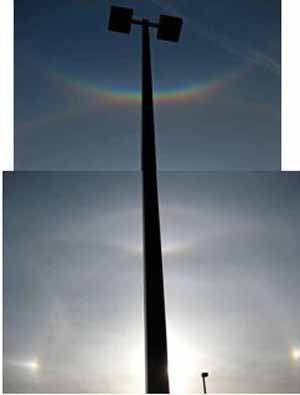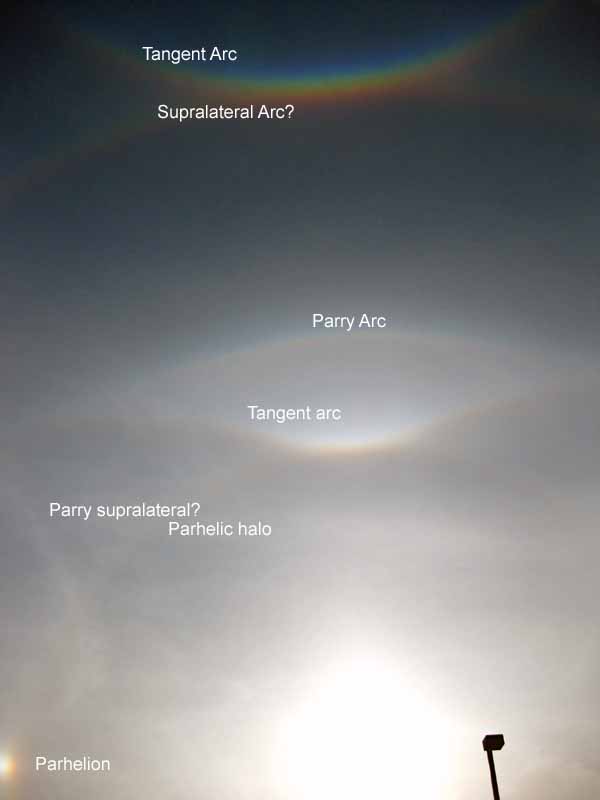Sun dogs, or parhelia, are bright spots, sometimes with rainbow colors, that appear in clouds on either side of the sun. They appear about a hand’s width away from the sun and at the same height above the horizon. You might have seen them but not known what they were called. You can see sun dogs near the setting sun quite often if you just look for them.
There are other optical displays that require conditions that are far less common. One afternoon in October, when I was leaving work in Huntsville, Al, the conditions were met. The setting sun combined with nearly complete coverage of high, thin clouds produced just about every kind of optical effect you could imagine or name. I took some pictures with my point-and-shoot Canon, but I couldn’t get everything in one frame. A NASA worker, though, saw the same thing and had a wide enough lens that he got an amazing shot.
This is my attempt to photograph the sun dogs, halos and arcs. I crudely combined two shots to try to get more of the display. You should really go look at the linked image to get a better appreciation of what this phenomenon looked like.

The sun is behind the lamppost at the bottom of the photo. The parhelia and other arcs and halos are visible.
The arcs and halos can be hard to identify. I think these are labeled correctly. The atoptics Web site gives a diagram with some labels for some rare arcs.

Parhelion and some arcs and halos. Some are not visible in this photo.
If you think the photos are impressive, you should have seen the real thing. It was like being put into the cover art from a 1950’s science fiction paperback. It didn’t look real.
All of these arcs and halos are the result of sunlight passing though six-sided ice crystals. The angles of the sides determine the directions that the sun’s rays are scattered. The types of crystals and their orientations determine where and what kind of halo can appear to an observer. The amount of cloud cover determines whether a given halo can appear at a given place.
There are Web sites that give plenty of the optical physics that explain in detail how halos are made, but I’ll try to give a brief overview. You may already know that when snow forms, it tends to be as six-sided, or hexagonal crystals. Ice crystals in clouds tend not to be as ornate as snowflakes, but they are still hexagonal. Sometimes they are thin, like flat plates. These crystals can be at any orientation, but they tend to want to settle into a horizontal orientation. The crystals can spin around and be at any angle to the sun. The crystals in a given area will send the sun’s rays into many directions; that’s why a cloud in front of the sun seems so bright. But there is a stronger reflection into the 22-degree direction, which makes that spot in the sky even brighter than the rest of the cloud.
Ice crystals can grow into longer shapes, like columns. The longer they get, the less they tend to settle in any particular orientation. If flat hexagons are more randomly oriented, because of turbulence of some other conditions in a cloud, they can combine with column-shaped crystals to reflect and refract the sun’s rays in other directions. These more random orientations also tend to redirect the sun’s rays into favored directions. If there happens to be the right kind of cloud in the right direction, you can see some of the many other types of halos. The clouds also have to be within a certain range of thickness. Too thin and the arcs and halos are too dim to see clearly. Too thick, and the sun’s rays can’t penetrate to the ground.
The display in October showed at least parhelia, much of a complete parhelic circle (a bright line going all the way around the horizon at the same height as the parhelia), the cirumzenithal arc (a circle going around the zenith, or the point directly above the observer’s location), the 22-degree halo (a halo around the sun at the same angular distance as the parhelia), the Parry arc, the Parry supralateral arc, some tangent arcs and others identified at the Earth Science Picture of the Day. If you look at the area within the parhelic arc, you might notice that it seems darker than most of the rest of the sky. That’s because the ice crystals tend not to reflect the sun’s rays into that region. It’s similar to the region of dark sky that occurs between the primary rainbow and the secondary rainbow. For rainbows, that region is called Alexander’s Dark Band, but, as far as I know, there is no name for the dark area inside the parhelic halo.
Sun dogs are pretty common. Some of the other arcs and halos are rare. This site gives relative frequencies of occurrences for some of them. The Parry arc, for example, occurs about one time for every 100 parhelia occurrences, which is about the number of times parhelia occur in Europe every year. That means that a Parry arc should occur about once a year. If you’re not looking, you’ll miss it. Of course these frequencies of occurrences are really frequencies of observations at a given location. There could be more occurrences that just aren’t observed. But the relative frequency of occurrence should be the same for observed and unobserved arcs and halos.
I’m going to say that this particular combination of arcs and halos is close to a once-in-a-lifetime event. I consider myself lucky to have seen it. I’ll consider myself extraordinarily lucky if I ever see it again. But I’m going to keep looking. And next time I’m going to try to make sure I have the right camera.